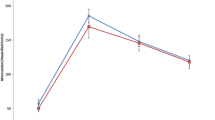Abstract
Purpose
To evaluate the ability of inferior vena cava-lesion-attenuation-difference (ILAD) and lesion-cortex-attenuation-ratio (LCAR) to differentiate renal oncocytomas (RO) from chromophobe renal cell carcinomas (chRCC).
Methods
Retrospective study with analysis of 84 cases of chRCC and 30 cases of RO confirmed by surgical pathology. ILAD was calculated by measuring the difference in Hounsfield units (HU) between the inferior vena cava and the lesion of interest on the same image slice on preoperative CT scan. Calculating LCAR using the CT attenuation ratio of lesion to renal cortex at the same image slice. Receiver operating characteristic (ROC) curves were plotted to analyze the diagnostic values of ILAD and LCAR for disease activity.
Results
There were no statistically significant differences in demographic and lesion characteristics between patients with chRCC and RO (p > 0.05). ILAD has significant statistical differences in the identification of RO and chRCC in the arterial (p = 0.031), venous (p = 0.047), and delayed phase (p = 0.002). And LCAR showed a statistically significant difference between two lesions during the arterial (p = 0.043), venous (p = 0.026), and delayed phase (p = 0.008). When all significant variables were used in combination to build a predicting model (Mix), the AUC was 0.871 (95% CI 0.759–0.984) with 67.9% sensitivity and 100% specificity.
Conclusion
ILAD and LCAR at the arterial phase, venous phase and delayed phase were shown to be useful CT attenuation parameter in discriminating RO from chRCC when histologic evaluation on biopsy is indeterminate.




Similar content being viewed by others
Data availability
All data and material are fully available without restriction.
References
Moch H, Cubilla AL, Humphrey PA, Reuter VE, Ulbright TM (2016) The 2016 WHO classification of tumours of the urinary system and male genital organs-part a: renal, penile, and testicular tumours. Eur Urol 70:93-105. https://doi.org/10.1016/j.eururo.2016.02.029
Giambelluca D, Pellegrino S, Midiri M (2019) The “central stellate scar” sign in renal oncocytoma. Abdom Radiol (NY) 44:1942–1943. https://doi.org/10.1007/s00261-019-01899-3
Wobker SE, Williamson SR (2017) Modern Pathologic Diagnosis of Renal Oncocytoma. J Kidney Cancer VHL 4(4):1–12. https://doi.org/10.15586/jkcvhl.2017.96
Wu J, Zhu Q, Zhu W, Chen W, Wang S (2016) Comparative study of CT appearances in renal oncocytoma and chromophobe renal cell carcinoma. Acta Radiol 57(4):500–506. https://doi.org/10.1177/0284185115585035
Motzer RJ, Bander NH, Nanus DM (1996) Renal-cell carcinoma. N Engl J Med 335:865–875. https://doi.org/10.1056/NEJM199609193351207
Kay FU, Pedrosa I (2018) Imaging of Solid Renal Masses. Urol Clin North Am 45(3):311–330. https://doi.org/10.1016/j.ucl.2018.03.013
Raman SP, Johnson PT, Allaf ME, Netto G, Fishman EK (2013) Chromophobe renal cell carcinoma: multiphase MDCT enhancement patterns and morphologic features. Am J Roentgenol 201(6):1268–76. https://doi.org/10.2214/AJR.13.10813
Dhyani M, Grajo JR, Rodriguez D, Chen Z, Feldman A, Tambouret R, Gervais DA, Arellano RS, Hahn PF, Samir AE (2017) Aorta-Lesion-Attenuation-Difference (ALAD) on contrast-enhanced CT: a potential imaging biomarker for differentiating malignant from benign oncocytic neoplasms. Abdom Radiol (NY) 42(6):1734–1743. https://doi.org/10.1007/s00261-017-1061-3
Lüders C, Kristiansen G (2016) Onkozytom versus chromophobes Nierenkarzinom. Der Pathologe 37(2):153–158. https://doi.org/10.1007/s00292-016-0145-0
Sun T, Hutchinson L, Zhou AG, Liu Q, Cosar EF, Cyr MS, Ninteau N, Dresser K, Cheng L, Jiang Z, Cornejo KM (2020) The Utility of ERBB4 and RB1 Immunohistochemistry in distinguishing chromophobe renal cell carcinoma from renal oncocytoma. Int J Surg Pathol 28(3):259–264. https://doi.org/10.1177/1066896919883016
Ng KL, Ellis RJ, Samaratunga H. Morais C, Gobe GC, Wood ST (2019) Utility of cytokeratin 7, S100A1 and caveolin-1 as immunohistochemical biomarkers to differentiate chromophobe renal cell carcinoma from renal oncocytoma. Transl Androl Urol 8(Suppl 2): S123-S137. https://doi.org/10.21037/tau.2018.11.02
Tickoo SK, Amin MB (1998) Discriminant nuclear features of renal oncocytoma and chromophobe renal cell carcinoma. Analysis of their potential utility in the differential diagnosis. Am J Clin Pathol 110:782–787. https://doi.org/10.1093/ajcp/110.6.782
Kutikov A, Smaldone MC, Egleston BL, Manley BJ, Canter DJ, Simhan J, Boorjian SA, Viterbo R, Chen DYT, Greenberg RE, Uzzo RG (2011) Anatomic features of enhancing renal masses predict malignant and high-grade pathology: a preoperative nomogram using the RENAL Nephrometry score. Eur Urol 60:241–248. https://doi.org/10.1016/j.eururo.2011.03.029
Paño B, Soler A, Goldman DA, Salvador R, Bunesch L, Sebastia C, Nicolau C (2016) Usefulness of MDCT to differentiate between renal cell carcinoma and oncocytoma: development of a predictive model. Am J Roentgenol 206(4):1–11. https://doi.org/10.2214/AJR.15.14815
Choi JH, Kim JW, Lee JY, Han WK, Rha KH, Choi YD, Hong SJ, Yong YE (2015) Comparison of computed tomography findings between renal oncocytomas and chromophobe renal cell carcinomas. Korean J Urol 56:695–702. https://doi.org/10.4111/kju.2015.56.10.695
Grajo, J, Terry R, Ruoss J, Nornnig B, Pavlinec J, Bozorgmehri S, Crispen P, Su LM (2019) Using Aorta-Lesion-Attenuation Difference (ALAD) on Preoperative Contrast-Enhanced CT Scan to Differentiate between Malignant and Benign Renal Tumors. Urology 125:123–130. https://doi.org/10.1016/j.urology.2018.11.036
Acknowledgements
The author thanks Shuai Ren, Huifeng Zhang for providing language help and Yingying Cao, Yaping Zhang, Xiaoyu Gu for data analysis. This study was supported by the Key Program of Research and Development of Jiangsu Province (BE2017772) and the National Natural Science Foundation of China (81771899).
Funding
This study was supported by the Key Program of Research and Development of Jiangsu Province (BE2017772) and the National Natural Science Foundation of China (81771899).
Author information
Authors and Affiliations
Contributions
KG: guarantor of integrity of the entire study. ZW, KG: study concepts and design. KG, YC, YZ, XG: literature research. HZ, KG: clinical studies. SR, KG: data statistical analysis. KG, SR: manuscript preparation. KG: manuscript editing.
Corresponding author
Ethics declarations
Conflict of interest
The authors report no other potential conflicts of interest.
Ethical approval
This study was approved by the institutional review board of the Affiliated Hospital of Nanjing University of Chinese Medicine and patient informed consent was waived due to its retrospective nature.
Consent to participate
Formal ethics approval and consent to participate was not required in this retrospective analysis of observational data.
Consent for publication
Publication consent was obtained from all authors.
Additional information
Publisher's Note
Springer Nature remains neutral with regard to jurisdictional claims in published maps and institutional affiliations.
Rights and permissions
About this article
Cite this article
Guo, K., Ren, S., Cao, Y. et al. Differentiation between renal oncocytomas and chromophobe renal cell carcinomas using dynamic contrast-enhanced computed tomography. Abdom Radiol 46, 3309–3316 (2021). https://doi.org/10.1007/s00261-021-03018-7
Received:
Revised:
Accepted:
Published:
Issue Date:
DOI: https://doi.org/10.1007/s00261-021-03018-7




